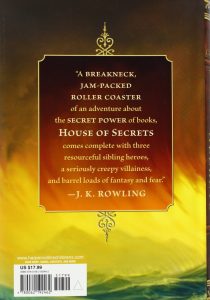The most haunting idea I was left with came from your gritty exposure of ugliness and weakness of human nature (it’s far too easy, after all, to write about the potential and existent beauty of our natures). How important is it to you that this kind of real-ness exists in your characters? And if your hope was to showcase this, do you have a goal in mind, in terms of how we can rise above or grow from humanity at its worst?
– Goodreads member Anne Gunden
This is a great question and I’m very glad it was chosen! Yes, it was very important to me that the characters felt like real people, with their confused motives and their complicated lives. Thomas Hardy, a writer who knew a lot about the desperation of poverty and of quiet rural lives, wrote: ‘If way to the better there be, it exacts a full look at the worst.’
I see the vast majority of the characters in The Casual Vacancy as trapped by circumstance, by their life choices or a mixture of both and I have especial sympathy for all five teenagers – Andrew, Fats, Sukhvinder, Gaia and Krystal – who are all suffering from what an astute reader described to me as ‘casual parenting’.
One of the things I thought about a lot while writing was how hard it is to change your life even as an adult, though some people face much bigger obstacles in doing so than others. Gavin Hughes, for instance (a character for whom I can muster very little affection or sympathy), is really blocked only by his own timidity and inertia. I find his total disengagement and his self-absorption unsympathetic and I must admit that (having my ignoble side as much as the next person) I rather enjoy Samantha’s goading of him. Then we have Kay, who has made a disastrous change to her life in moving to be near her disinterested boyfriend; Samantha, whose accidental pregnancy irrevocably changed her life and, at the fat end of the spectrum, Terri Weedon. She has been damaged so young and is so severely addicted, trapped among people who use or abuse her, that almost every aspect of her thought process, her emotional state and her external circumstances would have to be transformed to alter the course of her life.
Two major themes of the novel are hypocrisy and responsibility. I wanted to show how humans can have ugly feelings that they might prefer not to acknowledge; how we’re all caught up in our own problems and limited by our own life experience. To judge somebody else, to declare them substandard, to conclude that their misfortunes are due to inherent character flaws, can be a way of boosting our own self-esteem, because it must follow that our comparative success or happiness is not mere luck or chance, but the reward for superior morals or talent.
Yet none of that has to stop us doing wonderful things; perfection is not necessary to make a real and lasting difference to other people’s lives. Barry Fairbrother was not a saint in the eyes of his grieving wife; he may have stretched himself too thin in his determination to make a difference to the people trapped in the same kind of childhood he escaped, but had he lived, Krystal and Robbie would have lived, too.
You ask about rising above our baser nature to effect real change in the world and I feel that many of my characters do that at the end of the book. Colin shows real bravery, compassion and forgiveness for his deeply damaged son; has become Fats’ sole source of comfort. Kay has faced up to her own motives in moving to Pagford, resolved to repair the damage and been reconciled with her daughter. Parminder has recognised the bravery and the trauma of the daughter onto whom she has projected all her own dissatisfaction and insecurities. Perhaps most importantly of all, Samantha Mollison, who has been so discontented throughout the story, who has been scathing of the possibilities offered by government to make any real change, volunteers to join the local council. We are left with the impression that she will not vote with her husband; that she and Colin Wall will fight to keep the addiction clinic open and prevent more drug-related calamities.
The awful knowledge that she could have saved a small boy’s life has jolted Samantha out of her complacency and she wants to be absorbed in something bigger than herself. I suppose that is my real answer to the second part of your question: we need to become absorbed in something bigger than ourselves. That doesn’t mean that everyone should stand for parliament (God forbid); it is a more subtle business than that. If we make decisions in small matters in the awareness that our actions can have huge impact on others, we will begin to make a difference. If we choose to understand the other person’s point of view, if we make the effort to understand before rushing to judgment, all kinds of different vistas might become apparent to us. This might sound very little, but the effects could be world changing and many people would rather not do this much. It feels comfortable and secure to adhere to one viewpoint and not shift (I very much include myself in everything written here, by the way!)
In the final analysis, The Casual Vacancy was constructed so that when three characters walk past a small, unaccompanied boy who is wandering between a dangerous river and a road, we understand why none of them stopped to ask him why he was alone, or take charge of him. I chose each of those characters carefully. Gavin represents the utter apathy for which it is necessary (in the famous quotation) for evil to flourish. He cannot even remember seeing Robbie Weedon after he hears that he has drowned, nor is he troubled by the thought that he must have walked very close to the boy during his final moments.
Samantha represents the rush of everyday troubles that prevents basically well-intentioned people from concentrating on matters that do not directly concern them. She subsequently admits to having seen Robbie and feels deep remorse at not having acted. Samantha is also honest enough to acknowledge to herself that Robbie’s appearance made her less likely to help him.
Shirley represents a degree of unkindness that stems from her own basic insecurity, because her background is not so very far removed from that of the Weedons. I think it is very common for such people to be among the most critical and judgmental. She – not Howard – is Barry Fairbrother’s true opposite in the novel. Denying her roots and castigating those who remind her of them, she is the negative image of the man who admits where he came from and goes back to try and help others. Shirley not only sees Robbie and ignores him as she grapples with her own problems, she feels no remorse afterwards, merely heaping blame on others for the child’s death.
An interesting question is whether Howard would have stopped to help Robbie. I’d be fascinated to know what readers think, but I’m sure he would have done. Howard is a happy man, which makes a difference; happy people are often kinder than the unhappy. What is more, Howard can appreciate hardship and suffering when it is personalized. For instance, he pays credit to Cath Weedon, whom he acknowledges to have had a hard life and to have done her best in spite of all her disadvantages. Confronted with a dirty little boy wandering beside the river, I can well imagine Howard taking him firmly by the hand and leading him off the police station. However much I might disagree with Howard on many issues, he has his code, and it is not devoid of a decency that I think is absent in his wife.
This has been a discursive answer, but I was stimulated by the question!
Previous writing: « Cover quote: I wouldn’t change a thing
Next writing: Secret Keeper »

